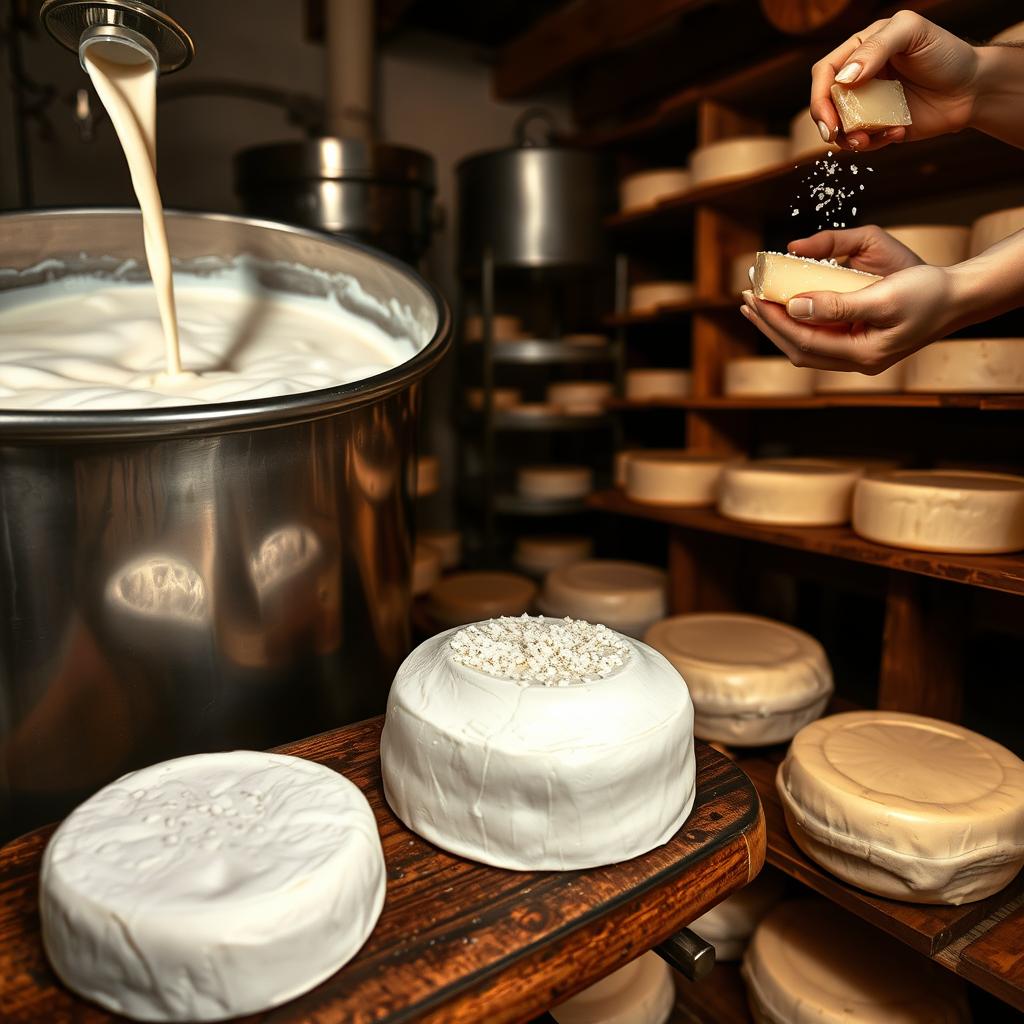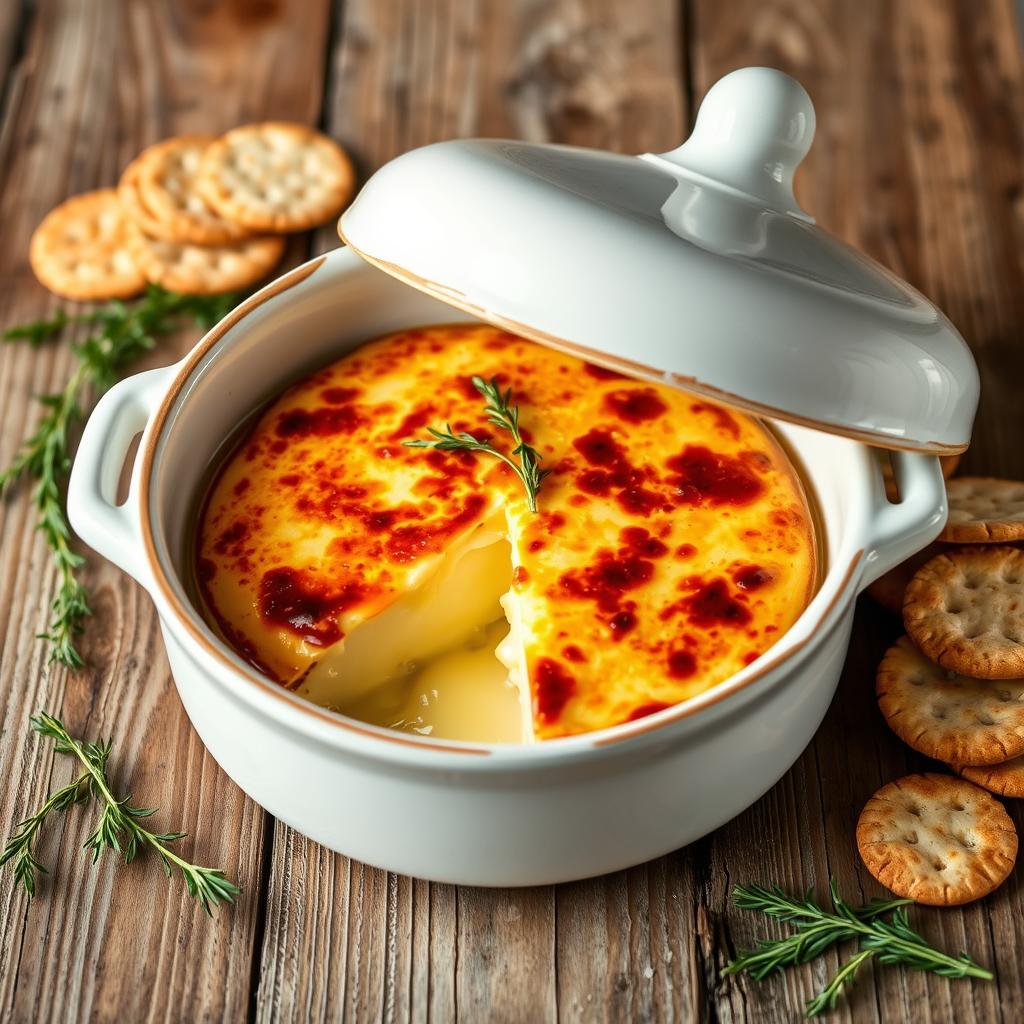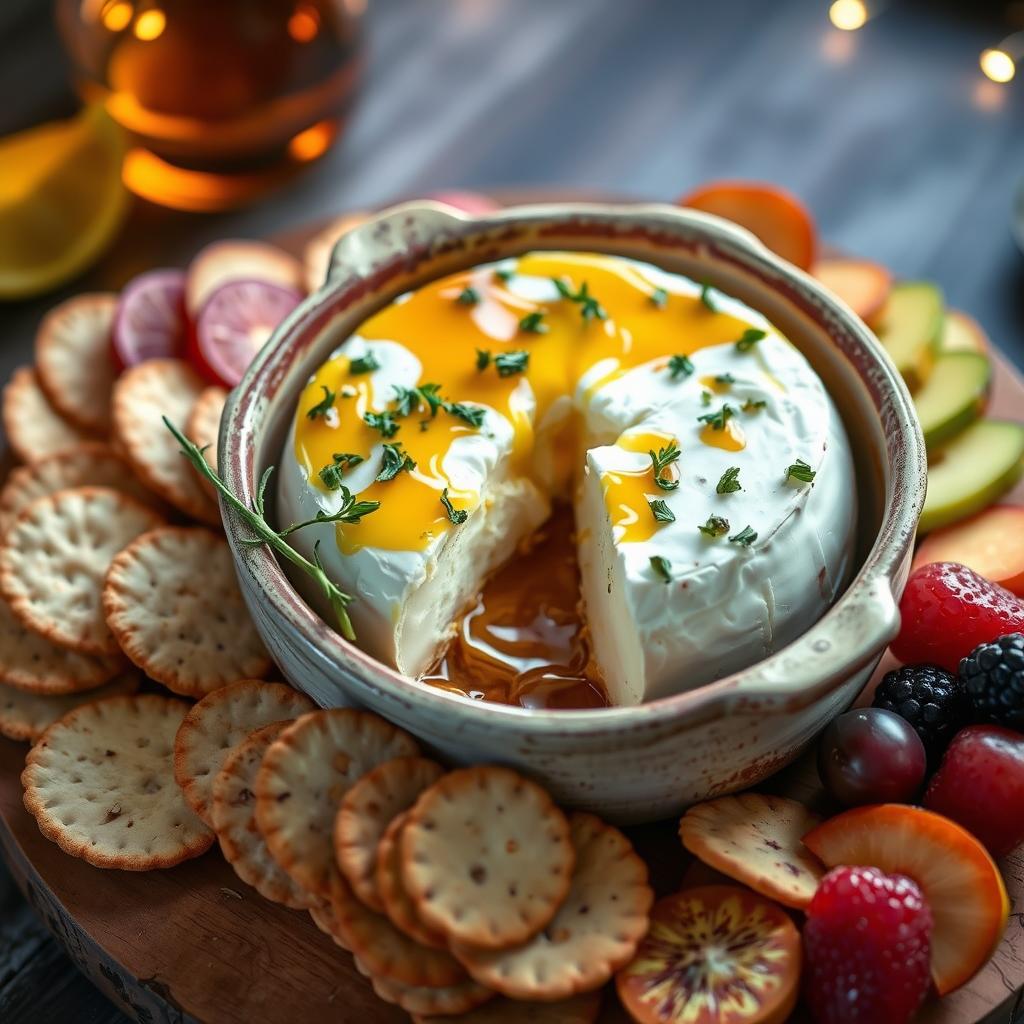Explore the world of French cheese making with a brie baker. It turns soft cheese into a delicious appetizer. Your journey into gourmet cheese begins here, blending traditional techniques with modern passion.
Baking brie is more than cooking—it’s an art. It turns this creamy French cheese into a stunning centerpiece. A brie baker lets you make dishes like a restaurant, melting the cheese to a perfect, velvety texture.
Whether you’re hosting a dinner party or having a quiet night in, mastering baked brie will wow your guests. It brings rich, complex flavors that honor French culinary traditions for centuries.
Key Takeaways
- Brie bakers unlock the full potential of soft French cheese
- Proper technique transforms brie into a gourmet experience
- Cheese making traditions inform modern cooking methods
- Baked brie serves as an elegant appetizer or centerpiece
- Temperature and timing are critical for perfect results
Understanding the Magic of Brie Cheese Making
Explore the world of artisanal cheese making, where tradition and skill come together. Brie cheese is a top example of dairy farming expertise. It has deep roots in French cheese-making traditions.

Making great brie starts with choosing the right milk from certain dairy areas. Cheesemakers use old techniques to turn raw milk into a creamy treat. This treat is a key part of French food culture.
Traditional French Cheese-Making Methods
French cheese making is a detailed process that makes brie stand out. Key steps include:
- Precise milk selection from specific dairy farms
- Careful culture and rennet addition
- Delicate curd cutting and molding
- Controlled drainage techniques
The Art of Cheese Affinage
Affinage, or cheese aging, is crucial for turning good cheese into exceptional brie. Skilled affineurs watch over temperature, humidity, and ripening conditions. They help develop the cheese’s unique flavor.
“Affinage is where cheese transforms from a simple dairy product to a complex culinary masterpiece.” – French Cheese Master
Regional Variations in Brie Production
France’s different regions make unique brie cheeses, each showing local terroir. From subtle flavor nuances to distinctive textures, these regional differences highlight the variety of cheese ripening techniques.
| Region | Brie Characteristic | Unique Feature |
|---|---|---|
| Île-de-France | Classic Brie de Meaux | Rich, buttery flavor |
| Seine-et-Marne | Brie de Melun | Stronger, more intense taste |
Learning about these detailed cheese-making processes helps you see the artistry in every brie bite.
What Makes a Brie Baker Special
A brie baker turns your cheese experience into something special. It’s a ceramic dish made just for melting brie perfectly. Home cooks and cheese fans love its unique features.

To understand a brie baker, let’s look at its design. These dishes are built with:
- Ceramic for even heat
- Raised edges to stop cheese spills
- Just the right depth for melting
- Looks great for serving
The main perk of a brie baker is the perfectly melted cheese it offers. Its design ensures your brie is just right, not too hot or too runny.
“A great brie baker is like a culinary magic wand for cheese enthusiasts” – Cheese Experts Quarterly
What makes a brie baker stand out includes:
| Feature | Benefit |
|---|---|
| Ceramic Material | Maintains consistent heat |
| Specialized Shape | Prevents cheese spillage |
| Elegant Design | Serves as both cooking and serving dish |
Buying a quality brie baker is more than just getting a cooking tool. It opens the door to creative cooking. It turns simple cheese into a gourmet delight.
Essential Tips for Brie in Brie Baker
Baking brie is a fun culinary journey. Knowing how long to bake it is key for that creamy, melted cheese delight.
To get the perfect baked brie, pay close attention and learn some expert tips. These will boost your cheese-baking skills.
Temperature Control Guidelines
Temperature is key when baking brie. You want to melt it just right without overcooking. Here are some important guidelines:
- Preheat your oven to 350°F (175°C)
- Use a brie baker or ceramic dish for even heating
- Place brie at room temperature before baking
Timing Your Bake Perfectly
Timing is crucial when baking brie. Different sizes need different baking times:
| Brie Size | Baking Time | Expected Result |
|---|---|---|
| Small (4-6 oz) | 8-10 minutes | Soft, gently melted center |
| Medium (8-12 oz) | 12-15 minutes | Creamy, fully melted texture |
| Large (16+ oz) | 15-20 minutes | Completely smooth, spreadable consistency |
Choosing the Right Accompaniments
Perfect accompaniments make your baked brie stand out. Try these pairings:
- Sweet options: Honey, fig jam, caramelized nuts
- Savory choices: Rosemary, thyme, cracked black pepper
- Serving suggestions: Crusty bread, crackers, fresh fruit
“The secret to perfect baked brie is patience and precision.” – Cheese Culinary Expert
Remember, every oven is different. Always keep an eye on your brie and adjust the time as needed. This will help you get that perfect, creamy texture.
Selecting the Perfect Brie for Baking
Exploring if you can bake any type of brie shows not all brie cheeses are the same. The secret to a great baked brie is picking the right cheese. It should melt well and taste amazing.
Different brie cheeses have their own special qualities for baking. Here are key things to think about when picking your cheese:
- Texture: Choose soft, creamy brie with a smooth feel
- Fat content: Cheeses with more fat melt smoother
- Ripeness: A bit underripe brie stays in shape better when baked
Classic French brie, like Brie de Meaux or Brie de Melun, are top picks. They offer rich, complex tastes that are perfect for baking. You might also find local artisanal cheeses at a specialty cheese shop for a unique baking experience.
“The right brie turns a simple appetizer into a culinary masterpiece.” – Cheese Enthusiast Magazine
Stay away from pre-packaged, mass-produced bries. They often lack the flavor and smooth melting you want. Go for fresh, high-quality brie wheels from trusted cheese makers for the best baking results.
Preparing Your Brie Baker for Use
A brie baker is more than a cooking tool. It’s a special device that turns cheese making into an art. To get delicious results, you need to prepare and maintain it well.
Before you start, you must know about seasoning and cleaning. These steps help your baker work better and last longer.
Seasoning Your Baker
Seasoning your brie baker makes it non-stick and cooks better. Here’s how to do it:
- Wash the baker with warm water and mild soap
- Dry it well with a clean towel
- Put a thin layer of cooking oil on it
- Bake at 250°F for 15-20 minutes
Cleaning and Maintenance Tips
To keep your brie baker in good shape, follow these cleaning tips:
- Let it cool down completely after use
- Wash it by hand with a soft sponge
- Stay away from harsh cleaners that can harm the ceramic
- Dry it right away to avoid water spots
“A well-maintained brie baker is the secret to consistently perfect baked cheese.” – Culinary Professionals
Ceramic brie bakers need special care. Always check the maker’s instructions for your model.
| Maintenance Task | Frequency | Purpose |
|---|---|---|
| Seasoning | Before first use | Create non-stick surface |
| Deep Cleaning | Monthly | Remove built-up residue |
| Inspect for Chips | After each use | Prevent further damage |
Investing time in proper brie baker care ensures years of delightful cheese making experiences.
The Role of Rind in Baked Brie
When making baked brie, many wonder if they should remove the rind. The answer is not simple. Brie’s white rind is key to its taste and texture.
Some ask if brie is better without the rind. The truth is, the rind adds special flavors. It’s safe to eat and gives a mild, earthy taste.
- The rind helps protect the soft interior of the cheese
- It adds complexity to the overall flavor profile
- Provides a beautiful visual texture when baked
Should you remove the rind? It depends on your taste and the recipe. Some like to keep the rind, especially with certain types of brie. The rind keeps the cheese from spreading too much.
| Rind Removal Method | Pros | Cons |
|---|---|---|
| Keep Rind Intact | Authentic flavor | Slightly firmer exterior |
| Remove Rind | Smoother texture | Loses some complex flavors |
“The rind is part of the cheese’s character – embrace it!” – French Cheese Artisan
Whether to remove the rind is up to you and your dish. Try both ways to find your perfect baked brie.
Creative Toppings and Flavor Combinations
Enhancing your baked brie experience is more than just the cheese. Wondering if you should score the top of brie before baking? Yes, you should! Scoring makes the cheese look great and lets toppings mix well with the cheese.
Trying new toppings can turn your brie into a culinary work of art. The right mix can make a simple cheese dish unforgettable.
Sweet Options for Baked Brie
- Honey and toasted pecans
- Raspberry jam with fresh thyme
- Caramelized apples and cinnamon
- Dark chocolate and sea salt
These sweet toppings offer a nice contrast to the creamy brie. They create a perfect mix of flavors that will wow your guests.
Savory Combinations to Try
- Herb-infused olive oil with roasted garlic
- Sun-dried tomatoes and basil
- Caramelized onions and fresh rosemary
- Cracked black pepper and truffle oil
If you like savory flavors, these options will make your baked brie taste like gourmet.
| Flavor Category | Top Recommendation | Preparation Tip |
|---|---|---|
| Sweet | Honey Pecan | Drizzle warm honey, sprinkle toasted pecans |
| Savory | Truffle Herb | Add truffle oil, fresh herbs before baking |
“The magic of baked brie lies in its versatility – a blank canvas waiting for your culinary creativity.” – Cheese Enthusiast Magazine
Pro tip: Always score the top of your brie lightly before adding toppings. This lets flavors mix well and makes a stunning presentation that will impress your guests.
Serving and Presentation Techniques
Improving your soft cheese presentation can turn a simple dish into a work of art. Serving baked brie is not just about taste. It’s also about making it look appealing. You want to create a spread that grabs attention and pleases your guests.
Experts suggest several ways to make your French cheese look stunning:
- Use rustic wooden boards or elegant ceramic platters
- Create height variations with different serving pieces
- Select complementary garnishes
- Consider color contrast with accompanying ingredients
“Great presentation turns an ordinary soft cheese into an extraordinary experience.” – Culinary Institute of America
Here are some artistic ways to plate your baked brie:
- Drizzle honey in elegant circular patterns
- Sprinkle fresh herbs like thyme or rosemary
- Add toasted nuts for textural complexity
- Incorporate fresh fruit for color and freshness
The key to amazing French cheese serving is to balance flavors, textures, and looks. Your presentation should encourage guests to savor every bite of the baked brie.
Common Mistakes to Avoid When Baking Brie
Baking brie can be tricky, even for experienced home cooks. Understanding potential pitfalls helps you create the perfect appetizer every time. Knowing how long do you leave brie in the oven? is just the start of mastering this delicious dish.
Baking brie requires precision and careful attention to detail. Many home chefs encounter challenges that can compromise the texture and flavor of this luxurious cheese.
Temperature-Related Issues
Temperature plays a critical role in baking brie successfully. Heating your cheese at the wrong temperature can lead to disastrous results:
- Overheating causes the brie to separate and become grainy
- Low temperatures prevent proper melting
- Inconsistent oven temperatures create uneven heating
Timing Missteps
Getting the timing right is crucial when considering how long do you leave brie in the oven. A few extra minutes can transform your creamy appetizer into a burnt disappointment.
| Mistake | Consequence | Solution |
|---|---|---|
| Overbaking | Dry, rubbery texture | Monitor closely, use timer |
| Underbaking | Cold, firm center | Ensure oven is preheated |
Pro tip: Most recipes recommend baking brie at 350°F for 15-20 minutes. Always watch your cheese closely and adjust based on your specific oven.
“Precision is the secret ingredient in perfect baked brie” – Culinary Experts
Remember, practice makes perfect! Each baking attempt will help you understand your oven and improve your technique.
Pairing Your Baked Brie with Wines and Beverages
Choosing the right drink can make your French cheese experience even better. It turns your baked brie into a true culinary delight.
Here are some top picks for wine pairings with baked brie:
- Champagne: Its bubbles and acidity balance the creamy cheese
- Pinot Noir: A light red that matches the cheese’s rich taste
- Chardonnay: Offers a smooth, buttery taste that contrasts well
“The perfect wine pairing should enhance, not overpower, the delicate flavors of your artisanal cheese.” – Cheese Sommelier
But wine isn’t the only choice. You can also try these non-alcoholic drinks:
- Sparkling apple cider
- Herbal tea
- Craft kombucha
Remember, the temperature of your brie and drink matters. They should be at the perfect temperature for the best taste.
Storing and Reheating Leftover Baked Brie
After enjoying your delicious baked brie, it’s important to store it right. This helps keep its quality and extend its life. The right storage can preserve the rich flavors and creamy texture you worked hard to achieve.
Refrigeration is key for cheese ripening and preservation. Here are some essential storage tips:
- Wrap the leftover brie tightly in plastic wrap or aluminum foil
- Store in an airtight container to prevent moisture loss
- Keep refrigerated at 40°F (4°C) or below
- Consume within 3-4 days for optimal taste and texture
When reheating your baked brie, gentle warming is crucial. Avoid microwaving, as it can harm the cheese’s delicate structure.
“Slow and steady wins the race when reheating brie” – Cheese Experts
Here are some recommended reheating methods:
- Preheat oven to 300°F (150°C)
- Remove brie from refrigerator 30 minutes before reheating
- Place in a small baking dish
- Warm for 5-7 minutes until slightly soft
Pro tip: Always let baked brie rest for a few minutes after reheating. This allows even temperature distribution and maximizes flavor.
Conclusion
Exploring baked brie opens a world of culinary fun. With a brie baker, you can turn soft cheese into a gourmet delight. You’ve learned how to make stunning baked brie dishes.
A brie baker lets you try many toppings, making French cheese a highlight of your meal. It’s perfect for dinner parties or cozy nights at home. You’ll improve your cooking and learn about soft cheese traditions.
Getting better at baking brie takes practice. Each try will make you better at controlling temperatures and mixing flavors. You’ll connect with French cheese making traditions.
Now you can make baked brie a special part of your meals. Start your baking journey, trust your taste, and enjoy the world of baked brie.
FAQ
What is a brie baker?
A brie baker is a special dish for baking and serving soft cheeses like brie. It’s round with raised edges to hold the cheese. It often has a lid to keep heat and moisture in.
Can I bake any type of brie?
Most soft cheeses work for baking, but choose a fresh, high-quality brie. Younger bries melt better than older ones. Look for a French brie that’s firm but soft to the touch.
Should I remove the rind before baking?
You don’t need to remove the rind completely. The rind helps keep the cheese in and adds flavor. But, scoring the top with a knife makes serving easier and looks better.
How long do I bake brie?
Bake brie at 350-375°F for 10-15 minutes. It should be soft and slightly bubbly but not melted. Watch it closely to avoid overcooking.
What are some good toppings for baked brie?
Try honey, fig jam, nuts, dried cranberries, or fresh herbs. You can choose sweet or savory toppings. Adding olive oil or balsamic glaze can also enhance the flavor.
Do I need a special brie baker to make baked brie?
A brie baker is ideal, but you can use other dishes too. Choose something oven-safe that lets the cheese melt evenly.
What are the best accompaniments for baked brie?
Enjoy baked brie with crusty bread, crackers, or fruit. A light white wine or sparkling wine complements the cheese well.
How do I store leftover baked brie?
Keep leftover baked brie in an airtight container in the fridge for 2-3 days. Reheat it in a low oven (around 250°F) until warm. This prevents the cheese from becoming tough.

